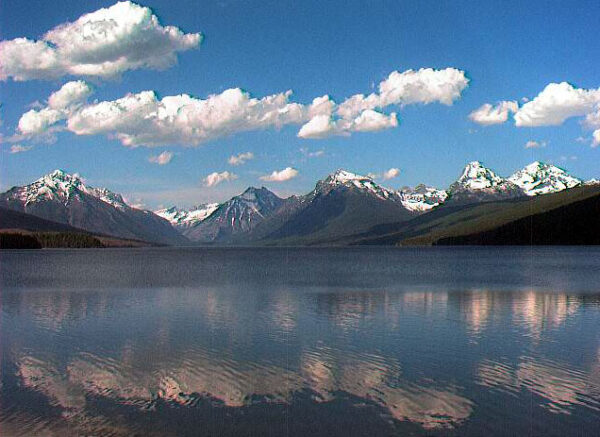Encyonopsis montana
-
Category
-
Length Range37-75 µm
-
Width Range7.0-8.8 µm
-
Striae in 10 µm19-21 at the valve center, 21-22 near the apices
-
Reported AsEncyonopsis cesatiformis (Krammer 1997, plate 186, fig. 1, p. 422)
Encyonopsis cesati var. geitleri (Bahls 2012, Diatoms of the US)
-
ContributorLoren Bahls - May 2013
-
ReviewerRex Lowe - Nov 2012
Identification
Description
Valves are rhombic-lanceolate and nearly symmetric with respect to the apical axis. Apices are rostrate and deflected slightly to the ventral side. The axial area is narrow. The central area is small, slightly asymmetric, and rounded on both sides. The raphe is lateral. Proximal raphe ends are deflected toward the dorsal side and distal raphe ends are hooked toward the ventral side. Striae are radiate throughout, more strongly radiate near the apices. Areolae are very fine and difficult to resolve in LM.
Note that figures 89 and 90 in the original description (below) are of Encyonopsis cesatiformis, not E. montana.
Autecology
Encyonopsis montana is widely distributed and locally abundant in lakes in the Northern Rockies and North Cascades. For collection sites with water quality data, pH ranges from 7.0 to 8.7 and specific conductance ranges from 13 to 92 µS/cm.
-
Size Range, µm3
-
Motility
-
Attachment
-
Habitat
-
Colony
-
Waterbody
-
Distribution
- Learn more about this
Original Description
Valves broadly lanceolate in smaller specimens to rhombic-lanceolate in larger specimens, with short rostrate apices deflected ventrally. Valves not or slightly dorsiventral. Valve length 26–75 µm; valve width 5.7–8.8 µm. Axial area narrow. Central area small, asymmetric, rounded on the dorsal side, rounded (large specimens) to irregularly notched (small specimens) on the ventral side. Raphe lateral, becoming filiform near proximal and distal ends. Proximal raphe ends weakly expanded, deflected dorsally. Distal raphe fissures comma-shaped, curved toward the ventral side. Striae weakly radiate (center) to strongly radiate (ends), 18–22 in 10 µm.
-
AuthorBahls 2013
-
Length Range26-75 µm
-
Width5.7-8.8 µm
-
Striae in 10µm18-22
Citations & Links
Citations
Links
-
Index Nominum Algarum
Updates
Nov 21, 2024 - Correction of taxon name
The specimens illustrated here were originally posted (11.28.2012) on the Diatoms of the US site as Encyonopsis cesati var. geitleri. Further investigation showed that the specimens were not of the type, but of a new species. That species was described as E. montana Bahls 2013. The correction to the taxon name was made. - L. Bahls
Nov 21, 2024 - Split of taxon to narrow concept
The specimens illustrated here were earlier posted (09.01.2013) on the Diatoms of the US site as Encyonopsis montana together with two smaller specimens that were subsequently determined to belong to E. cesatiformis. The two smaller specimens have been moved to a new page for E. cesatiformis. - L. Bahls
Cite This Page
Bahls, L. (2013). Encyonopsis montana. In Diatoms of North America. Retrieved November 21, 2024, from https://diatoms.org/species/encyonopsis_montana
Responses
The 15 response plots show an environmental variable (x axis) against the relative abundance (y axis) of Encyonopsis montana from all the stream reaches where it was present. Note that the relative abundance scale is the same on each plot. Explanation of each environmental variable and units are as follows:
ELEVATION = stream reach elevation (meters)
STRAHLER = distribution plot of the Strahler Stream Order
SLOPE = stream reach gradient (degrees)
W1_HALL = an index that is a measure of streamside (riparian) human activity that ranges from 0 - 10, with a value of 0 indicating of minimal disturbance to a value of 10 indicating severe disturbance.
PHSTVL = pH measured in a sealed syringe sample (pH units)
log_COND = log concentration of specific conductivity (µS/cm)
log_PTL = log concentration of total phosphorus (µg/L)
log_NO3 = log concentration of nitrate (µeq/L)
log_DOC = log concentration of dissolved organic carbon (mg/L)
log_SIO2 = log concentration of silicon (mg/L)
log_NA = log concentration of sodium (µeq/L)
log_HCO3 = log concentration of the bicarbonate ion (µeq/L)
EMBED = percent of the stream substrate that is embedded by sand and fine sediment
log_TURBIDITY = log of turbidity, a measure of cloudiness of water, in nephelometric turbidity units (NTU).
DISTOT = an index of total human disturbance in the watershed that ranges from 1 - 100, with a value of 0 indicating of minimal disturbance to a value of 100 indicating severe disturbance.

Encyonopsis montana
- Valves large
- Valves rhombic-lanceolate
- Apices rostrate
- Striae strongly radiate near apices
Valves are rhombic-lanceolate and large, up to 75 µm long and 8.8 µm wide. Apices are rostrate. Striae are strongly radiate near the apices. No stigma is present.
 Diatoms of North America
Diatoms of North America






